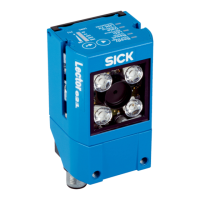350 Stop by
The Stop by parameter is used to select the signal source/condition for closing the
reading gate.
•
B STOP BY (signal for closing the reading gate)
When the reading gate is open, the sensor captures images at a frequency of 60 Hz
and evaluates them on the basis of codes. In an ideal scenario, at least one of the
codes on one of the images will be captured fully and recognized. No images are cap‐
tured while the reading gate is closed.
Signal sources for closing the reading gate:
•
NOT DEFINED: No function defined for closing the reading gate
•
READ CYCLE SOURCE: The reading gate is closed by the same signal source that
opened it (e.g., the reading gate opens as soon as an object trips a photoelectric
switch and closes again as soon as the object is clear of the photoelectric switch).
•
SENSOR / INPUT 1: A signal at digital input 1 (e.g., from a photoelectric switch) causes
the reading gate to close.
•
SENSOR / INPUT 2: A signal at digital input 2 (e.g., from a photoelectric switch) causes
the reading gate to close.
•
EXTERNAL INPUT 1: A signal at external digital input 1 (e.g., from a photoelectric
switch) causes the reading gate to close.
•
EXTERNAL INPUT 2: A signal at external digital input 2 (e.g., from a photoelectric
switch) causes the reading gate to close.
•
SOPAS COMMAND: A corresponding standard command for closing the reading gate is
expected from a device such as an external control (PLC) (a detailed list of the
commands can be obtained from SICK on request).
•
TIMER / DISTANCE: The reading gate remains open for a defined time/distance (Read‐
ing gate length). If the speed of the objects remains constant, no incremental
pulse is required (Increment source). If the speed varies, the current speed can,
for example, be calculated on the basis of signals from a rotary encoder. As a
result, the reading gate can be closed as soon as the object has covered a specific
distance, regardless of the object speed.
•
GOOD READ: The reading gate closes as soon as the GOOD READ condition is met (e.g.,
the required number of codes has been read). This ensures that the reading gate
is only kept open for as long as necessary (direct feedback concerning whether a
code has been identified).
•
USER-DEFINED COMMAND: For the purpose of closing the reading gate, you can freely
define a corresponding command that is generated by a device such as an exter‐
nal control (PLC) and transmitted to the sensor.
•
MATCH 1 CONDITION: The reading gate closes as soon as the condition is met.
•
MULTICODES1 CONDITION: The reading gate closes as soon as the number of detected
codes corresponds to the number specified.
•
TEACH-IN1 CONDITION: The reading gate closes as soon as the Match-code teach-in 1
condition is met.
•
TEACH-IN2 CONDITION: The reading gate closes as soon as the Match-code teach-in 2
(Additional) condition is met.
SOPAS PARAMETER OVERVIEW
116
O N L I N E H E L P | Lector62x 8013778/YPV6/2016-01-14 | SICK
Subject to change without notice

